Publication Information
ISSN: 2641-6859
Frequency: Continuous
Format: PDF and HTML
Versions: Online (Open Access)
Year first Published: 2018
Language: English
| Journal Menu |
| Editorial Board |
| Reviewer Board |
| Articles |
| Open Access |
| Special Issue Proposals |
| Guidelines for Authors |
| Guidelines for Editors |
| Guidelines for Reviewers |
| Membership |
| Fee and Guidelines |
 |
Body Fat Percentage and Adductor Flexibility Affect The Lunge Length in Fencing – A Correlation Study
Hardik Arvindbhai Patel*
Lead Sports Physiotherapist, Vijayi Bharat Foundation, Sanskardham Campus, Ahmedabad, Gujarat, India
Received Date: March 30, 2024; Accepted Date: April 12, 2024; Published Date: April 28, 2024;
*Corresponding author: Hardik Arvindbhai Patel, Lead Sports Physiotherapist, Vijayi Bharat Foundation, Sanskardham Campus, Ahmedabad, Gujarat, India. Email:hardikpatel151@gmail.com; physiotherapy@vijayibharat.org; Contact Number: +91-9898-19-8283
Citation: Hardik Arvindbhai Patel, Body Fat Percentage and Adductor Flexibility Affect The Lunge Length in Fencing – A Correlation Study (2024) Biology or Gender Identity in Sport. Adv Ortho and Sprts Med: AOASM-197.
DOI: 10.37722/AOASM.2024201
Abstract
Background: Fencing is a technically demanding sport that relies on the precise execution of offensive and defensive fundamental lunge and leg movement requires extremely high and well-coordinated motions decisive for combative tasks and has been largely investigated the various anthropometry and performance related parameters which includes velocity, reaction time, neuromuscular coordination, lunge length, leg power and specific hand and leg kinematics pattern among different age group in three competitive weapons. Additionally, hip mobility and flexibility play a pivotal role in executing the lunge effectively, requiring neuromuscular balance and a healthy range of motion in the lower extremities; so, the Aim of the present study was to evaluate any relationship between the Body fat percentage and lunge Length/ Lunge length height ratio (LLHR); adductor flexibility and lunge length among fencers.
Material & Methodology: In this Correlation study, 50 fencers in different weapon category (Foil (n-17), Epee (n-15), Sabre (n-18)) between 15 to 23 years were selected through inclusion and exclusion criteria. A Stadiometer was used for height measurement and body fat % were performed using the bioelectrical impedance analysis before the breakfast using the body composition analyzer. Adductor flexibility (BKFO Test) and Fencing Lunge length were measured after the routine warm up protocol.
Results: The data was analysed using the SPSS Version 26.0. Result revealed a weak negative (R = -0.48; p = 0.0004) relationship between lunge length height ratio (LLHR) and body fat percentage (%) among the fencers and also showed no correlation (R = 0.047; p = 0.74) between dominant lunge length and adductor flexibility.
Conclusion: Primarily Body fat % and adductor flexibility does not predict the lunge length pattern among fencers.
Keywords: Fencing, Lunge Length, adductor Flexibility (BKFO Test), body fat %
Introduction
Fencing is a highly technical sport that depends upon fencers’ ability to repeat offensive and defensive leg movements that require dynamical leg patterns, shorts bouts of high-intensity attacks, and long bouts of low-intensity preparatory actions and recovery periods [1, 2]. Offensive movements are powerful actions that a fencer aims to make a hit against the opponent on his initiation or immediately after a successful defensive action, executed correctly at the right moment [2].
Fencing lunge is an offensive fundamental explosive skill standardized by the fencers’ ability to generate a great amount of force in limited time concerning anthropometric traits. In that perception, lunge requires extremely high and well-coordinated motions decisive for combative tasks and has been largely investigated the various anthropometry and performance related parameters which includes velocity, reaction time, neuromuscular coordination, lunge length, leg power and specific hand and leg kinematics pattern among different age group in three competitive weapons [3,4,5,6]. Kinematic analyses of fencing lunge identified a sequential activation of the elbow extensors of the dominant arm followed by the relative activation of the hip, knee, and ankle muscles that dictates the correct technique associated with fencing success.
The anthropometrical characteristics of fencer shows the different percentage of body fat as a result of different training program. A relatively high level of body fat as well as lower value of lean body mass have a negative effect on performance in male and female fencers [7].
Hip Mobility and flexibility are the essential component to execute the lunge in coordinated pattern which require a neuromuscular balance and healthy ROM in lower extremity. Tightness and stiffness over the hamstring, adductor and Lateral hip musculature compromise the healthy ROM and dynamic functional movement, which increase the musculoskeletal injuries risk in lower extremity. The BKFO is an adductor flexibility test, involving a combination of hip flexion, abduction and external rotation (Malliaras et al., 2009); and a high result is generally considered to be related to adductor muscle “tightness” specifically that of the adductor longus [8].
More information is needed concerning the association between Lunge Length and adductor flexibility and body fat % measures to create evidence-based conclusions that may be useful to further weapon specialized fencing training, talent optimization and injuries prevention. Thus, the present study’s purposes are to identify any correlation between the Body fat percentage and lunge Length; adductor (adductor longus) flexibility and lunge length among fencer having different ages, gender level, and training specialization. It was hypothesized that male and female Fencers in different fencing weapons (epee, foil, and sabre) shows the variability in their anthropometry profile and their lunge pattern also depends on the on-guard Position, foot work and kinematics pattern, hence, a strong correlation was expected between the adductor (adductor longus) flexibility and Body fat % in Lunge length distance among the fencers.
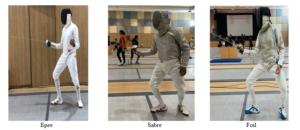
Material and methodology
A correlation study was designed with the approval from the institute and informed consent was obtained from each subject who participated in the study. Fifty residential academy athletes (training year 2022-2023) from Vijayi Bharat Sports Academy, Sanskardham Campus, Ahmedabad were screened for inclusion criteria having an age group of 15 to 23 years in three different fencing weapons (foil- 17; epee- 15 and sabre- 18) categories and having experience of state and national participation in their respective age group (Table 1- Subjects Details). Any subject who had History of lower limb #, ACL Reconstruction, Hamstring or lower extremity muscle repair in past 6 Months and having any current Musculoskeletal injuries over the lower leg were excluded from the study.
Table – 1 – Subjects Details
| Foil (n- 17) | Epee (n-15) | Sabre (n-18) | |
| Age (Yr.) | 18.41 ± 2.00 | 17.93 ± 2.21 | 17.66 ± 1.57 |
| Height(cms) | 165.71 ± 10.16 | 170.60 ± 9.65 | 166.01 ± 9.21 |
| Weight (kgs) | 56.44 ± 8.66 | 58.9 ± 9.65 | 58.81 ± 8.14 |
| % of body Fat | 18.22 ± 8.61 | 21.53 ± 7.81 | 20.81 ±8.31 |
The Fencer’s height, weight and body fat (%) were determined before the adductor Flexibility and lunge length test. A Stadiometer was used for height measurement and body fat % were performed using the bioelectrical impedance analysis before the breakfast using the body composition analyzer (In body 370 S; segmental body composition analyzer, South Korea) (Refer Table 2- Anthropometry characteristic of Male and Female Fencers- Foil, Epee and Sabre).
Table – 2 – Anthropometry characteristic of Male and Female Fencers
| Foil men
(n-10) |
Foil Women
(n-7) |
Epee men
(n-6) |
Epee Women
(n-9) |
Sabre men
(n-8) |
Sabre women
(n-10) |
||
| Age (Yr.) | 18.6 ± 2.17 | 18.14± 1.86 | 18.5 ± 2.66 | 17.55 ± 1.94 | 17.87 ± 1.64 | 17.5 ± 1.58 | |
| Height(cms) | 170.67 ± 8.22 | 158.62 ± 8.63 | 177.78 ± 8.65 | 165.82 ± 6.93 | 171.53 ± 8.04 | 161.6 ± 7.83 | |
| Weight (kgs) | 59.44 ± 10.33 | 52.17 ± 3.63 | 61.25 ± 10.18 | 57.33 ± 9.55 | 60.06 ± 10.51 | 57.81 ± 6.06 | |
| % of body Fat | 12.15±2.91 | 26.9 ± 5.9 | 13.15±3.15 | 27.12 ± 3.59 | 12.85±3.03 | 27.19±4.66 | |
| Lunge Length | 141.9 ± 19.6 | 97.8 ± 10.2 | 146.3 ± 12.6 | 125.7 ± 11.2 | 146.1 ± 14.16 | 128.2 ± 8.85 | |
The fencers performed a routine training warm-up protocol before the assessment of adductor (adductor longus) flexibility and dominant Lunge length. Bent Knee fall out test for adductor flexibility (95% CI 0.87-0.95) (Figure 1)- The fencers were positioned in a crook lying with their knee flexed to 90 degree and their feet together. They were instructed to allow their knees to fall outward while keeping their feet together, and the examiner used gentle overpressure to check that the player had relaxed at the limit of movement. The distance between the most distal point on the head of the fibula and the surface of the floor/ plinth was measured using an inflexible tape and recorded.
The lunge movement in fencing includes 3 main successive steps; through which the weapon should have a steady motion towards the opponent. First, the tip is put in line the armed hand is extended and sword is pointed to the target Second, through a fast motion, immediately on having the arm extended, the front leg is kicked forward and also pulling the pelvis and the body center of the gravity forward. Finally, in the third step, once the front leg has been kicked, the back leg straightened quickly. The length of dominant side lunge was measured with the use of inflexible tape from the on-guard line to the landing of lead leg (heel) in their respective weapon category. Lunge length in different weapon category were measured; Sabre (136.16 ± 14.46 cm) and epee (134 ± 15.40 cm) group covered the more distance in lunge compare to foil fencers. (123.76 ± 27.47 cm). Lunge length Height ratio (LLHR) were calculated and compare with the body fat %.
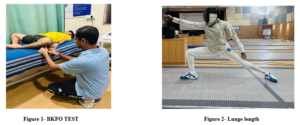
Data Analysis
The data was analysed using Microsoft Excel version 11 and SPSS software version 26.0. The Pearson corelation was used to corelation the Dominant lunge length Height ratio and body fat %, Dominant lunge length and Bend knee fall out (BKFO) test. A significance level was set at (p<0.05).
Protocol
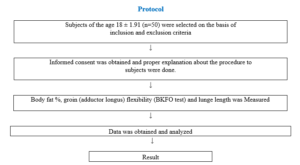
Result
Pearson correlation revealed a weak negative (R = -0.48; p = 0.0004) relationship between lunge length height ratio (LLHR) and body fat percentage (%) among the fencers. (Refer Graph – 1). Results also showed a no any relationship (R = 0.047; p = 0.74) between dominant lunge length and adductor flexibility (BKFO) test (Graph -2) among Fencers.
Graph – 1 Dominant Lunge length Height ratio (LLHR) – body fat % (R = -0.48; p = 0.0004)
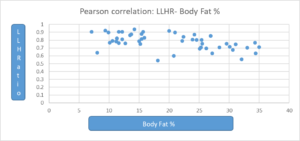
Graph – 2; Dominant Lunge length – BKFO Test (R = 0.047; p = 0.74)
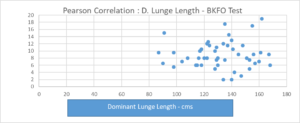
Discussion
This study aimed to identify any correlation between the Body fat % and lunge Length height ratio; lunge length and adductor flexibility among fencers having an experience of state and national level competition. Data analysis revealed a weak negative relationship between dominant lunge length height ratio and body fat percentage (%) among the fencers. Giulio S. Roi and Diana Bianchedi (2008); stated the variability of body fat percentage among fencers in different training age and weapon category primarily due to the training specialization; female fencers show the higher body fat percentage; Excess body fat in athletes can negatively affect their strength-to-weight ratio, speed, agility, and power in competitive sports; athletes with a higher body fat percentage may find it more challenging to generate explosive movements and achieve optimal performance.
There is no any relationship between lunge length and Bent knee fall out test which address the adductor flexibility. According to the various research “flexibility is the ability to make movements in the joint space so, increasing flexibility reduces the stress around the joints. The range of movement increases when the muscles around the joints are in optimal length tension relationship; can help reduce the risk of injury during the dynamic movement. Hip Flexors, Hip Extensors, Hip adductor and Hip abductor muscles plays a key role in dynamic hip movement among athletics population [9,10,11]. Lunge length and explosive power of lower leg will also depend up on the relative strength and co-contraction of the muscles around the hip joint which require an optimal length tension relationship and neuromuscular control of agonist, antagonist and synergist muscles. Several studies have shown that legs with previous hamstring and adductor injury or poor hamstring and adductor flexibility had smaller flexion angles corresponding to the maximal knee flexion torque compared to legs without previous injury or with normal hamstring flexibility [12,13]. A recent study demonstrated that the hamstring muscle-tendon unit lengths at which maximal contraction forces are produced (hamstring optimal lengths) were significantly correlated to hamstring flexibility score and sex, but not to hamstring strength (10). Here in present study adductor flexibility have no any relationship with the lunge length which support the lunge biomechanics- optimal eccentric and concentric work of hamstring, quadriceps, Glutes and adductor should be require for the fundamental lunge movement.
Chen TL-W, Wong DW-C, Wang Y, Ren S, Yan F, Zhang M (2017) noted the variability in the lunge length due to the different on guard position, offensive lunge technique and temporal arm leg movement involved in fencing kinematics [14]. The characteristic of the fundamental movement involved in the lunges have also shown the variability among the different weapon category (epee, foil and sabre) primarily due to the training specialization and nature of the games [15]. Sabre fencers from Vijayi Bharat Sports Academy noted more attacking on guard stance position and having an advantage of the explosive lower extremity movement which might affect the lunge distance compare to the normal on guard stance in similar anthropometry characteristic and flexibility among the others fencers.
Limitation of Study
The study was conducted on smaller sample size with inclusion of both genders. Fencer’s training age, on guard’s stance and technical preparation in different weapon backgrounds also compromised the result. The generalization of such results to elite athletes with high level of training adaptation needs to be validated.
Conclusion
Primarily Body fat % and adductor flexibility does not affect the lunge length pattern among fencers. The movement involved in the lunges is more dependent on the fundamental stance, foot work, optimal co contraction of muscles, explosive power, speed and weapon specific training and control involved in different weapon category.
Acknowledgements: We extend our deepest gratitude to all those who contributed to the completion of this research article conducted at the esteemed Vijayi Bharat Foundation.
- First and foremost, our heartfelt appreciation goes to Mr. Rajnish Sinha, the Chief Operating Officer, whose unwavering support and encouragement have been instrumental throughout this journey. We acknowledge the invaluable support provided by dedicated Sports Physiotherapist team, sports science staff and fencing coaches of Vijayi Bharat Foundation, whose expertise and assistance significantly enriched the research process.
- Finally, we express our gratitude to all the members of the organization, athletes whose contributions, whether direct or indirect, have been vital to the completion of this study.
- Thank you all for your invaluable support, encouragement, and cooperation.
References
- Roi GS, Bianchedi D. The science of Fencing. Sports Medicine. 2008;38(6):465–81. doi:10.2165/00007256-200838060-00003
- Harmbenberg J, Ceci R, Barvestad P et al. Comparison of different tests of fencing performance. Int J Sports Med 1991; 12: 573-6.
- Ntai A, Tsolakis C et al. Anthropometric and Leg Power Factors Affect Offensive Kinetic Patterns in Fencing. Int J Exerc Sci. 2021; 14(4): 919-931.
- Barth B, Beck E. The complete guide to fencing. Oxford, UK: Meyer and Meyer Sport; 2007
- Guilhem G, Giroux CC, Chollet D, Rabita G. Mechanical and muscular coordination patterns during a high-level fencing assault. Med Sci Sports Exerc. 2014; 46(2): 341-50.
- Turner A, James N, Dimitriou L, Greenhalgh A, Moody J, Fulcher D, Mias E, Kilduff LP. Determinants of Olympic fencing performance and implications for strength and conditioning training. J Strength Cond Res. 2014; 28(10): 3001–3011.
- Tsolakis CH, Bogdanis GC, Vagenas G. Anthropometric profile and limb asymmetries in young male and female fencers. J Hum Mov Stud. 2006; 50: 201-16.
- Serner A, Lichau O et al. Evaluation of the bent knee fall out test pre and post an adductor longus tenotomy. Physical Therapy in Sports. 2021; 48: 196-200.
- Chen TL-W, Wong DW-C, Wang Y, Ren S, Yan F, Zhang M. Biomechanics of fencing sport: A scoping review. Plos One. 2017; 12(2):
- Wan X, Qu F, Garrett WE et al. Relationships among hamstring muscle optimal length and hamstring flexibility and strength. J Sport Health Sci 2016; 6(3):275–282
- Williams LR, Walmsley A. Response timing and muscular coordination in fencing: a comparison of elite and novice fencers. J Sci Med Sport. 2000; 3: 460–475.
- Fjerstad BM, Hammer RL et al. Comparison of Two Static Stretching Procedures on Hip Adductor Flexibility and Strength. Int J Exerc Sci. 2018; 11(6): 1074-1085.
- Li, W.E. Garrett, T.M. Best et al. Effects of flexibility and strength interventions on optimal lengths of hamstring muscle-tendon units. J S A M S. 2020; 23: 200–205
- Aresta S, Musci M et al. Motion Technologies in Support of Fence Athletes: A Systematic Review. Appl Sci. 2023; 13:1654.
- Cronin J, McNair P, Marshall R. Lunge performance and its determinants. J Sports Sci. 2003; 21(1): 49-57.